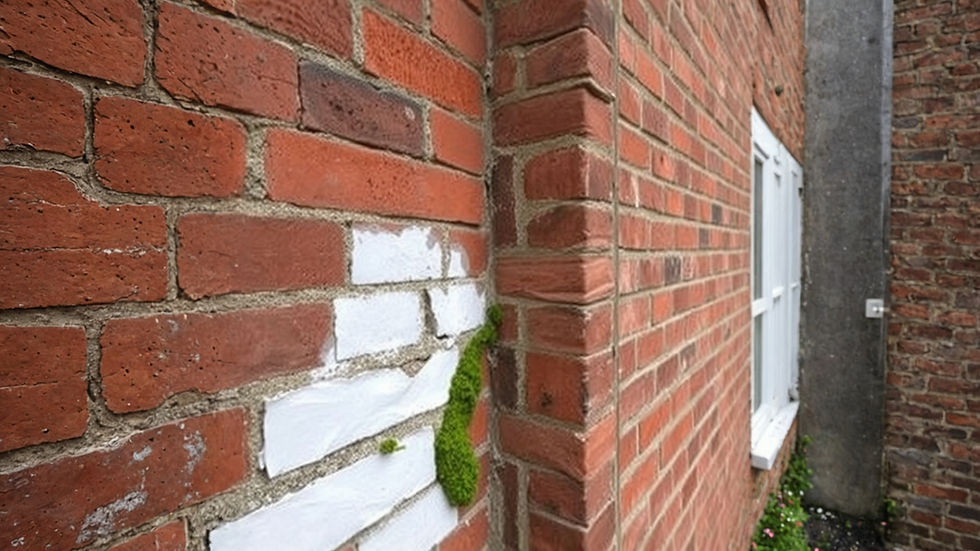How Damp Affects Brickwork: Early Signs and Repairs
- John Mayers
- Jun 18
- 4 min read
Damp is a silent destroyer that can cause significant damage to buildings, especially brickwork. Over time, unchecked moisture can weaken structural integrity, reduce insulation efficiency, and even lead to health issues. Whether you’re a homeowner or a property manager, understanding how damp affects brickwork—and how to address it—is crucial.
This guide explores the impact of damp on brickwork, early warning signs, and effective solutions like damp proofing, including when to book a damp survey or treat rising damp.
Why Damp is a Problem for Brickwork
Brick is a durable material, but it’s not immune to moisture. When exposed to excessive damp conditions, brickwork can absorb and retain water, especially if it's not properly protected. Over time, this leads to problems such as:
Crumbling mortar joints
Spalling (surface flaking of bricks)
Moss or algae growth
Salt deposits (efflorescence)
Reduced thermal efficiency
Without prompt damp proofing, moisture can penetrate deeper into the structure, damaging both internal and external surfaces.
Understanding the Causes of Damp in Brickwork
There are several causes behind damp problems in brick walls. Recognising these will help you decide when professional intervention is needed.
1. Rising Damp
Rising damp occurs when moisture from the ground travels up through bricks and mortar due to capillary action. This usually affects walls up to one metre high and is often visible as stained or bubbling plaster indoors. One key sign is a distinct musty smell.
2. Penetrating Damp
This type of damp enters from outside, usually due to faulty guttering, damaged render, or cracks in the wall. It can affect any part of the wall and tends to worsen after rainfall.
3. Condensation
Often mistaken for other damp issues, condensation forms when warm, moist air meets a cold surface. While it may not damage the bricks directly, persistent moisture encourages mould growth and deteriorates internal finishes.
Early Signs of Damp Damage in Brickwork
Detecting early signs of damp can save you a lot of money and trouble. If you notice any of the following, it’s time to consider a damp survey:
White, powdery patches on walls (efflorescence)
Cracking or crumbling mortar
Mould or mildew around skirting boards and lower wall sections
Cold, damp patches on interior walls
A damp, earthy smell inside the property
Visible signs of water ingress or discolouration on exterior brick walls
These symptoms can appear slowly and may be overlooked until the problem becomes severe. A routine inspection by a damp proofing specialist can help you catch issues early.

What is a Damp Survey and Why is it Important?
A damp survey is a professional inspection carried out by a qualified surveyor or technician to assess the level and type of damp in a property. This involves:
Moisture meter readings
Visual checks for signs of rising damp, penetrating damp, or condensation
Inspection of wall cavities, ventilation, and DPC (damp proof course)
The results provide a detailed report, guiding the right damp proofing treatment to prevent further deterioration. If you're buying or renovating a property, a damp survey is highly recommended to uncover hidden moisture issues before they cause major damage.
Damp Proofing Methods to Protect Your Brickwork
Once damp is identified, applying the correct damp proofing solution is vital to preserve your building’s structural integrity.
1. Damp Proof Course (DPC)
A DPC is a barrier installed near the base of external walls to stop ground moisture from travelling upwards. If your property lacks one or has a damaged DPC, a chemical injection can be applied to create a new waterproof layer.
2. Waterproof Render and Sealants
For penetrating damp, applying waterproof coatings to external brickwork can protect against rainwater ingress. Silicone-based sealants are breathable, allowing moisture to escape while keeping rain out.
3. Improved Drainage and Ventilation
Sometimes, the solution is as simple as improving drainage, clearing gutters, or enhancing ventilation indoors to reduce condensation.
4. Repointing
Damaged mortar joints should be repointed to stop water from seeping in. Repointing involves removing the old mortar and replacing it with fresh mix to seal gaps.
Each treatment must be tailored to the specific type and source of damp, so a damp survey is always the first step before undertaking major repairs.
Long-Term Effects of Ignoring Damp
Neglecting damp proofing doesn’t just harm brickwork—it affects the entire building. Long-term exposure to moisture can lead to:
Rotten timber and floorboards
Decreased energy efficiency due to wet insulation
Devaluation of the property
Potential health issues from mould spores
In severe cases, structural damage could make areas unsafe or require costly restoration. Acting early with the help of a professional damp survey ensures your property stays dry, healthy, and secure.
When to Call a Damp Specialist
If you're unsure about the source of damp or see signs like peeling paint, bubbling plaster, or salt marks on brickwork, it's best to call in a professional. They’ll assess the situation, provide a full report, and recommend the best damp proofing solution.
Don’t wait until the damage is visible—prevention is always more affordable than repair.
Final Thoughts
Damp may seem like a minor inconvenience, but left untreated, it can lead to major problems—especially in brick structures. From rising damp creeping up your walls to penetrating damp soaking through external bricks, moisture can seriously compromise your building’s integrity.
Booking a professional damp survey and acting on its recommendations ensures effective damp proofing, preserving both your property’s value and safety.



Comments